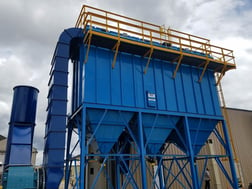Following procedures and performing maintenance is essential to ensuring safety and performance in industries ranging from aviation to medicine; not surprisingly, it is also true for dust collection. To ensure that a baghouse continues to run efficiently and to protect people and equipment, operators need to adhere to a checklist of regularly scheduled inspections followed by timely repairs as needed.

Naturally, every baghouse will have its specific set of checklist items, which should be determined in consultation with the system’s manufacturer, but the procedures outlined here are a good starting point.
Inspection/Maintenance Program: A baghouse’s preventive maintenance checklist should include periodic inspections with specific items performed on a daily, weekly, monthly, semi-annual and annual basis.
Pressure Drop: Pressure drop (or differential pressure) is the level of static resistance experienced when operating a positive or negative pressure baghouse. It’s typically measured across the filter bags in inches of water column (in. w.c.). Pressure drop can indicate the amount of dust collected on the filter media; if continually monitored and logged, pressure drop can also provide an indication of the condition of the bags themselves. New filter bags have the lowest pressure drop; as the bags develop a dust cake, the pressure drop will increase accordingly.
Keeping a daily log of a baghouse's differential pressure starting on the day new filter media is installed helps to diagnose problems that may occur (e.g., increasing dust emissions, reduced ventilation air at the dust source, shortened bag life, etc.). Following the filter bags’ initial seasoning or conditioning period, the pressure drop should stabilize into a consistent operating range relative to the cleaning cycle, application and style of equipment. Any deviation should trigger an investigation.
Cleaning System: A cleaning system is the method used to dislodge accumulated dust cake from the filter media. Without an effective cleaning system, dust will continue to build on the bags, leading to an increased pressure drop and reduced volume of ventilation air at the pick-up points. Airstream velocities within the ductwork will decrease and cause dropout of dust in the ducts, choking the entire system. Pulse valve malfunctions and pulse clamps that come loose can also affect cleaning system performance.
Hopper Discharge: A baghouse’s hopper is not intended for storing the collected product. This can lead to dust bridging or it might form a solid mass that can be difficult to remove. This mass can fill a hopper to its inlet and plug the unit. With low-density materials, the airstream could sweep the dust into the bag section, ruining filter bags and clogging the dust collector.
Visible Emissions: Any visual particulate emissions indicate a potential breach in a seal or a torn filter bag. Exceeding permitted particulate emission limits is one problem. Not only can such emissions create health problems and property damage, but a fan located downstream of the collector can be damaged by abrasion or become imbalanced if this condition is not corrected quickly.
Exhaust Fan: An exhaust fan accelerates ventilation air from the point of pickup through the ductwork and baghouse filter media and out the exhaust stack. A fan is selected to accommodate each application with respect to volume (ACFM) and pressure drop throughout the system. This pressure drop is calculated by evaluating the static resistance of the baghouse, all ductwork and pickup points/hoods. If an exhaust fan has loose or worn belts or an imbalanced impeller, it can’t exhaust the volume of air it was originally designed to handle. Without adequate ventilation air, a dust collection system can’t operate effectively.
Filter Media: Periodic inspections of the filter bags are mandatory. Inspect the clean air side of the baghouse for leaks.. Pressure drops substantially higher than previous ones may be the result of excessive dust cake or blinding of the filter bags. If the dust cake has hardened to the bags and won’t dislodge easily, moisture in the baghouse is the most likely cause.
Structural Integrity: An overall inspection should be done annually, including the welds, joints and flange seals. Check the structural support members for signs of fatigue and excessive corrosion. Make sure all fasteners are in place and tightly secured, especially on the ladder and access platform. Replace any missing bolts, clean and re-weld any cross bracing or gussets that may have cracked welds. Look closely at the filter's external walls for corrosion or signs of bowing. Repair any holes that may have developed in the dust collector walls or hopper(s).
Auxiliary Equipment: These items include the exhaust fan, rotary airlock valve, screw conveyor, inlet and/or outlet dampers, etc. Follow the manufacturer’s recommended maintenance procedures.
Ductwork: Periodic inspection of the entire length of ductwork for dust accumulation is strongly advised. Standard practice suggests a minimum airstream velocity within any duct of 3500 feet per minute (fpm), and between 4000 and 4500 fpm for heavier dusts, such as sand. Inadequate velocities will cause dust to tend to settle and accumulate in the ducts, choking the system. This flow restriction will increase the pressure drop in the system and the energy required to get the air moving.
To learn more about how to create a preventive maintenance checklist tailored for your specific baghouse dust collector, download a free copy of “Maintenance Checklist for a Better Baghouse” or contact your Sly representative for assistance.




